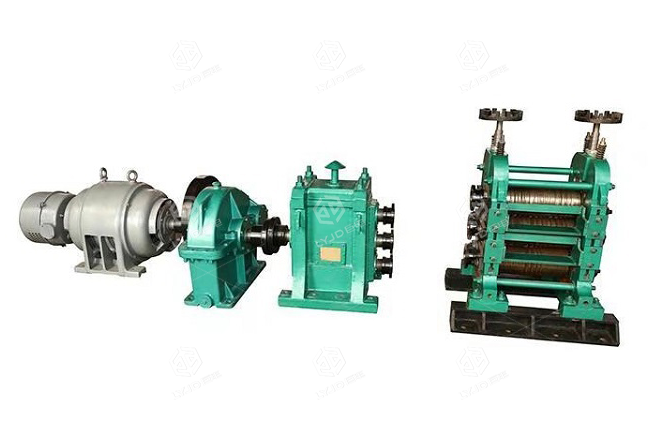Rebar is produced by the small rebar rolling mill. The main types of small rolling mills are: continuous, semi-continuous, and horizontal.
At present, most of the new and in-use small rolling mills are fully continuous in the world. Today's popular steel bar mills include general-purpose high-speed rolling steel bar mills and 4-segment high-yield steel bar mills.
The billet used in the continuous small rolling mill is generally a continuous casting billet, the side length is generally 130~160mm, the length is generally about 6~12 meters, and the billet unit weight is 1.5~3 tons.
At present, new technologies such as high-pressure water dephosphorization, low-temperature rolling, and endless rolling are mostly used in bar rolling. Rough rolling and intermediate rolling are developed to adapt to large billets and improve rolling precision. The machine is mainly to improve accuracy and speed.
The production process of the small rebar rolling mill is as follows:
Heating furnace→rough rolling mill→intermediate rolling mill→finishing mill→water cooling device→cooling bed→cold shear→automatic counting device→baler→unloading stand
Let's get some information about rebar.
There are two commonly used classification methods for rebar:
One is based on the geometric classification, according to the cross-section shape and rib spacing different classifications, such as the British standard, the rebar is divided into type Ⅰ, and type Ⅱ. This classification mainly reflects the grip performance of the rebar.
Second, based on performance classification, such as the Chinese standard, the strength level will be divided into 3 levels of rebar;
In the Japanese industrial standard, rebar is divided into 5 types according to its comprehensive properties. The British standard also specifies several grades of rebar performance tests.
In addition, the rebar can be classified according to its use, such as ordinary rebar for reinforced concrete and heat-treated rebar for reinforced concrete.
In general, the ordering principle of rebar is based on mechanical process performance or mechanical strength index on the basis of meeting the requirements of grip performance required by engineering design.
The specification requirements of rebar shall be set out in the import and export trade contract. Generally, it should include the standard grade, the nominal diameter of the steel bar, the quality, the specified length, and the allowable difference of the above indexes.
The standard recommends rebar series with nominal diameters of 8, 10, 12, 16, 20, and 40mm.
The surface quality of rebar steel has been stipulated in the relevant national standards. It is required that the end should be cut flat and straight, the surface should not have cracks, scarring, and folding, and there should be no harmful defects in use.
External dimension deviation allowable value.
The requirements of bending degree and geometry of rebar are stipulated in relevant national standards. Some national standards stipulate that the bending degree of the straight bar is not greater than 6mm/m, and the total bending degree is not greater than 0.6% of the total length of the bar.
This is our share today. I hope it can be helpful to you. Welcome to pay attention to Luoyang Judian for more information about steel rolling production.

Please send us your request and we reply to you with in 24 hours.
Submit Request